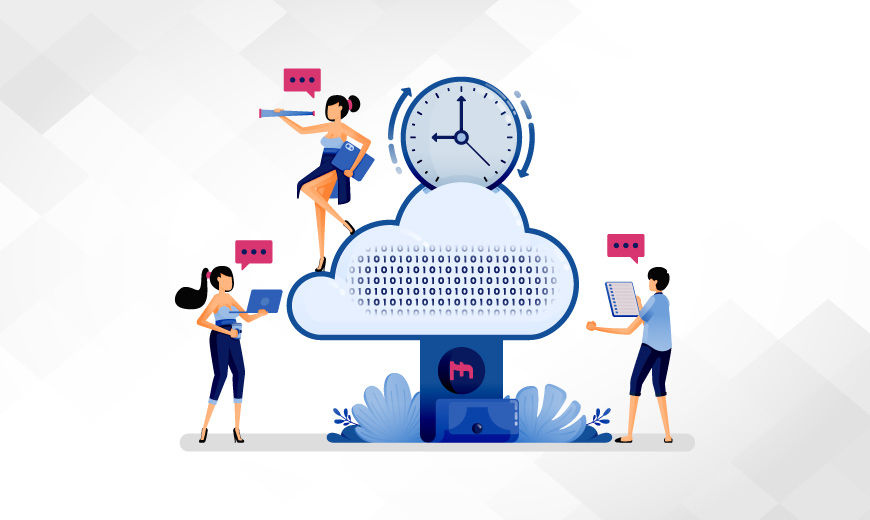Unplanned system downtime is a curse for businesses dependent on cloud infrastructure to offer their services. It not only poses financial losses but also hampers the company’s reputation. However, improving and maintaining the server’s uptime requires effort and expert guidance. In this detailed guide on how to prevent system downtime, we have listed 10 expert tips to counter cloud system downtime. Keep reading!
Secure maximum uptime—implement these strategies today.
A] Understanding System Downtime
System downtime is when a server goes offline due to unforeseen causes. It prevents facilities from accessing data or running their software in the cloud, leading to an operational halt. Unplanned server downtime not only causes financial loss but also hampers business reputation. Therefore, ensuring that your server is fully maintained for maximum uptime is crucial to mitigate the possibility of business operation halts.
Let’s first understand the common causes before exploring the tips for cloud system downtime prevention.
B] Common Causes of Cloud System Downtime
1. Hardware Failures
Hardware failure is the leading cause of cloud system downtime, as it involves the physical breakdown of computing resources, like storage devices, motherboards, etc. Hardware failure primarily happens due to hardware overheating, which leads to its malfunction. Other reasons for hardware failure include integrating old and faulty components and putting loads on computing resources beyond their threshold.
2. Software and Application Errors
Software and application errors are other prime causes of server downtime. It may include bugs, crashes, or incompatible updates that hamper system integrity and lead to application errors. Poor testing is also a culprit for server unavailability, as cloud infrastructure requires periodic and meticulous testing of the integrated hardware, software, and applications. Consequently, skipping or poorly done testing results in system downtime.
3. Cybersecurity Threats
Over four in ten businesses (nearly 43%) have reported cyber breaches in their cloud systems in the last 12 months. This data demonstrates how cybersecurity threats have become one of the main reasons for business operational halts. The hackers disturb the ecosystem of the cloud network by sending fraudulent traffic (known as a DDoS attack) and encrypting the files for ransom (known as ransomware).
4. Power Outages and Environmental Factors
Each cloud computing hardware and software requires power to run. If a power outage happens, systems automatically shut down and turn the server status from available to unavailable. Environmental factors, like natural calamities, earthquakes, and other uncontrollable disasters, also cause servers to fail and lead to unplanned downtime.
C] 10 Proven Downtime Reduction Strategies
1. Regular System Maintenance
Regular system maintenance keeps the software and hardware updated and prevents hardware and software failure. When planning for system maintenance, ensure you have a rollback plan to return to the stable version in case any unexpected fluctuation happens during updates. Low-usage times are the best for system maintenance, so plan accordingly and never miss it to show the server’s status as ‘available’.
2. Implement Redundancy
Redundancy implementation refers to preparing a redundant server that quickly takes over the load (failover) in case the primary server is down. This server is a backup server that provides uninterrupted cloud services without pushing your business offline. Absolute Cloud, a trusted cloud service provider in India, knows the importance of server redundancy implementation. That’s why we provide automatic failover among 5+ internet providers, ensuring you get unstoppable cloud services even when the primary server fails, which is extremely rare.
3. Move Critical Workloads To The Cloud With Reliable SLAs
Moving your critical workloads to the reliable cloud service providers also provides valuable space to your server, reducing the chances of performance bottlenecks. Moving critical workloads also allows you to leverage the power of modern and reliable cloud infrastructure engineered to minimise downtime in controlled conditions.
4. Robust Monitoring Tools
Integrating real-time monitoring tools into cloud infrastructure lets you track the performance and issues of cloud computing resources. It allows you to act upon the problems proactively and predict fluctuations in the system through data analysis provided by the monitoring tools.
5. Disaster Recovery Planning
Disaster recovery plans use cloud resources to back up data and applications and restore them after a disruptive event to ensure business continuity. To plan for disaster recovery, you must identify vulnerabilities, define recovery objectives (RTOs & RPOs), and document planning with transparent processes and roles.
6. Cybersecurity Measures
Implementing extremely robust security measures into your cloud infrastructure makes your cloud system fully proof. The unbreachable cybersecurity measures, like firewall protection, intrusion detection, and integrating AI/ML-based antivirus, ensure you remain protected from cyber threats, thereby having no unplanned downtime.
7. Load Balancing
If your cloud infrastructure is full of heavy traffic loads and stored data, invest in load balancing to mitigate future unplanned downtime. Since performance bottlenecks cause systems to overheat, slow down, and ultimately stop, distributing loads across multiple servers reduces the server load and allows servers to work smoothly and swiftly.
8. Employee Training
Employee training plays a vital part when looking for tips that guide you on how to reduce or prevent server downtime. It trains humans to configure systems, update software, and handle systems without errors. The training should also equip the employees to resolve the issues at their level, eliminating the need for early escalation and speeding the resolution process.
9. Proactive Hardware Checks
Proactive hardware checks allow cloud infrastructure to be updated. It ensures outdated or stressed equipment is replaced before failure. Proactive checks also ensure system maintenance is done on time, the disaster recovery plan is ready to execute, and data is backed up.
Secure maximum uptime—implement these strategies today.
10. Work with Trusted Hosting Providers
Trusted hosting providers offer higher reliability by continuously upgrading their cloud infrastructure and implementing modern hardware and software. They have the skills to bring downtime to a minimum through utilising technologies, like robust security protocols, server failover, and temperature-controlled ambience for reducing equipment heating, among others.
If you feel the shared tips are overwhelming and require day and night efforts to achieve the maximum server uptime, why not work with a trustworthy cloud hosting provider that takes care of all of the above without your intervention?
An experienced cloud hosting provider has the skills and expertise to manage servers. They know how to provide maximum uptime without halting your business’s services. They implement various modern and unknown technologies to keep the cloud service running almost every time. If you agree, choose Absolute Cloud, a trusted provider of cloud-dedicated servers in India, and keep your services online nearly all the time.
Absolute Cloud is known for offering a nearly 100% uptime guarantee with industry-grade security protocols, unlimited scalable infrastructure, dedicated support, disaster recovery, and daily backups. You may think, ‘This could be expensive.’ No, we are known for providing beyond-industry-grade cloud computing services at a fraction of the cost of what other major cloud computing companies charge.
If you are ready to experience blazing-fast speed with a nearly 100% uptime guarantee, contact us today and taste the speed and availability of our dedicated server!
We also offer video streaming servers for ed-tech and streaming businesses. This server is all you need if you are into streaming businesses.

Mr. Sachit Saraf
Director of Absolute Cloud and a second-generation leader in cloud computing, Sachit excels at merging technology with business acumen. With expertise in data analytics, business intelligence, and cloud solutions, he is committed to providing secure, 24/7 online access to critical software. Sachit’s passion lies in leveraging analytics for data-driven decisions, optimising processes, and driving transformative growth in the tech industry.


